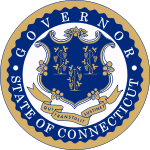Charles H. Pond
| Charles H. Pond | |
|---|---|
.jpg) | |
| 22nd and 24th Lieutenant Governor of Connecticut | |
|
In office 1850–1851 | |
| Governor | Thomas H. Seymour |
| Preceded by | Thomas Backus |
| Succeeded by | Green Kendrick |
|
In office 1852–1853 | |
| Governor | Thomas H. Seymour |
| Preceded by | Green Kendrick |
| Succeeded by | Vacant |
| 37th Governor of Connecticut | |
|
In office October 13, 1853 – May 3, 1854 | |
| Lieutenant | Vacant |
| Preceded by | Thomas H. Seymour |
| Succeeded by | Henry Dutton |
| Personal details | |
| Born |
April 26, 1781 Milford, Connecticut |
| Died | April 28, 1861 (aged 80) |
| Political party | Democratic |
| Spouse(s) | Catherine Dickinson |
| Alma mater | Yale University |
| Profession | lawyer, politician |
Charles Hobby Pond (April 26, 1781 – April 28, 1861) was an American politician who was the 22nd and 24th Lieutenant Governor of Connecticut (1850 to 1853) and who served as the 37th Governor for seven months (1853–1854) after the resignation of Governor Thomas Hart Seymour.
Biography
Born in Milford, Connecticut on April 26, 1781, Pond was the son of Captain and Martha (Miles) Pond. Prepared by his pastor, he attended college beginning at age seventeen and graduated from Yale University in 1802. He studied law with Hon. Roger Minot Sherman, of Fairfield, for two years and admitted to the bar in Fairfield County. Instead of beginning practice, he took a long sea voyage for his health and it suited him so well that he took another. The result was he followed the sea for several years as an employee of his father's shipping business;[1] first as a supercargo, then as captain. Regaining his former health he took up his residence on land again.[2] He was married in 1809 to Catherine Dickinson and they had seven children.[3]
Career
Pond served as an associate judge of New Haven County Court from 1818 to 1819, sheriff of New Haven from 1820 to 1834, and again as judge of New Haven County Court from 1836 to 1837.
Pond was elected Lieutenant Governor of Connecticut in 1850, 1852, and 1853. On October 13, 1853, Governor Thomas H. Seymour resigned from office, and Pond, who was Lieutenant Governor at the time, assumed the duties of Governor. During his tenure, the U.S. Senate passed the Kansas-Nebraska Bill, which caused great controversy throughout the state. (The act made slavery legally possible in a vast new area and revived the bitter quarrel over the expansion of slavery, which had died down after the Compromise of 1850, hastening the start of the Civil War.) Pond did not seek reelection and left office, retiring from public service.[4]
Death and legacy
The same month and year of the bombardment of Fort Sumter, Pond died on April 28, 1861 (age 80 years, 2 days). He is interred at Milford Cemetery, Milford, Connecticut.[5] He is memorialized on the Milford Founding Fathers Memorial in Milford.
References
- ↑ "Charles H. Pond". Connecticut State Library. Retrieved 1 December 2012.
- ↑ "Charles H. Pond". familyhistory.us.org. Retrieved 1 December 2012.
- ↑ "Charles H. Pond". Connecticut State Library. Retrieved 1 December 2012.
- ↑ "Charles H. Pond". National Governors Association. Retrieved 1 December 2012.
- ↑ "Charles H. Pond". The Political Graveyard. Retrieved 1 December 2012.
External links
| Wikimedia Commons has media related to Charles H. Pond. |
- National Governors Association biography
- F.C. Norton, "The Governors of Connecticut" (1905), Charles H. Pond entry
- Milford Founding Fathers Memorial
- familyhistory.us.org
- Connecticut State Library
- The Political Graveyard
| Political offices | ||
|---|---|---|
| Preceded by Thomas Backus |
Lieutenant Governor of Connecticut 1850–1851 |
Succeeded by Green Kendrick |
| Preceded by Green Kendrick |
Lieutenant Governor of Connecticut 1852–1853 |
Succeeded by Vacant |
| Preceded by Thomas H. Seymour |
Governor of Connecticut 1853–1854 |
Succeeded by Henry Dutton |
